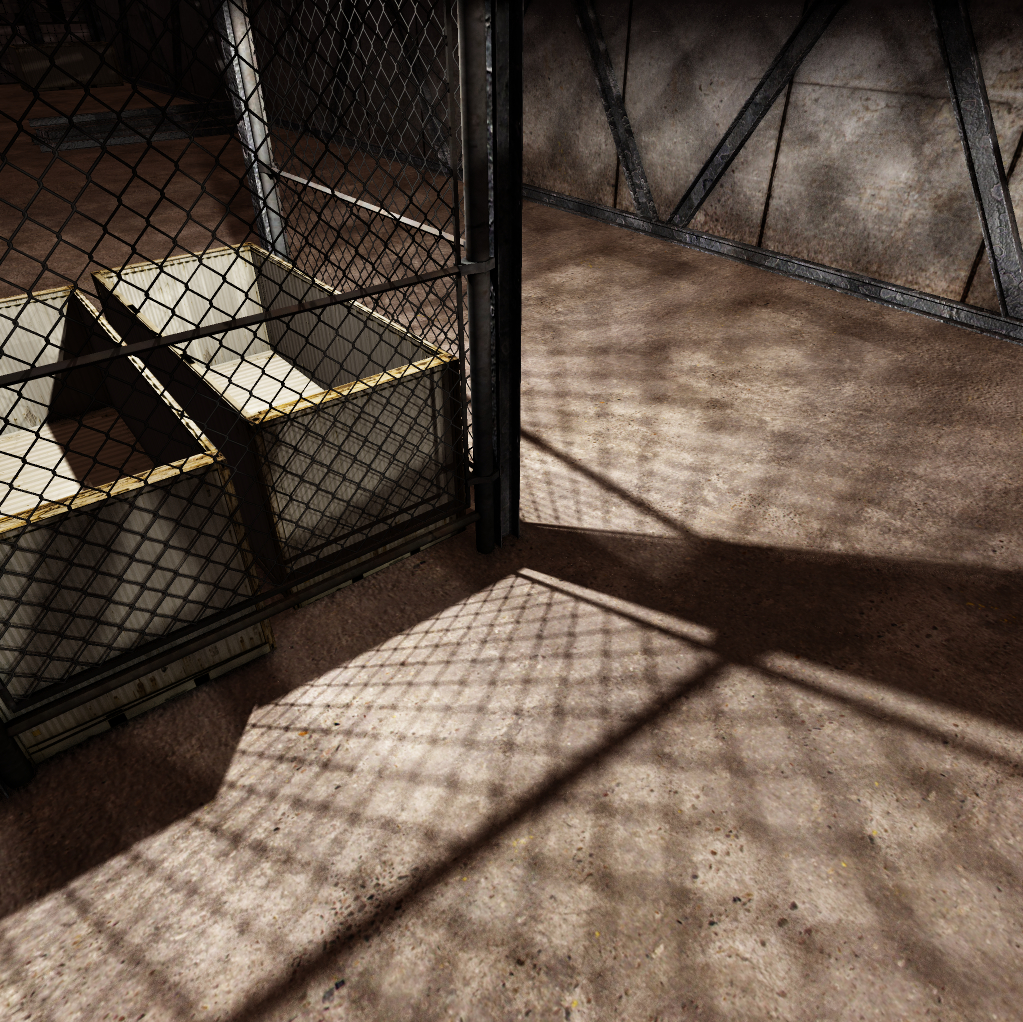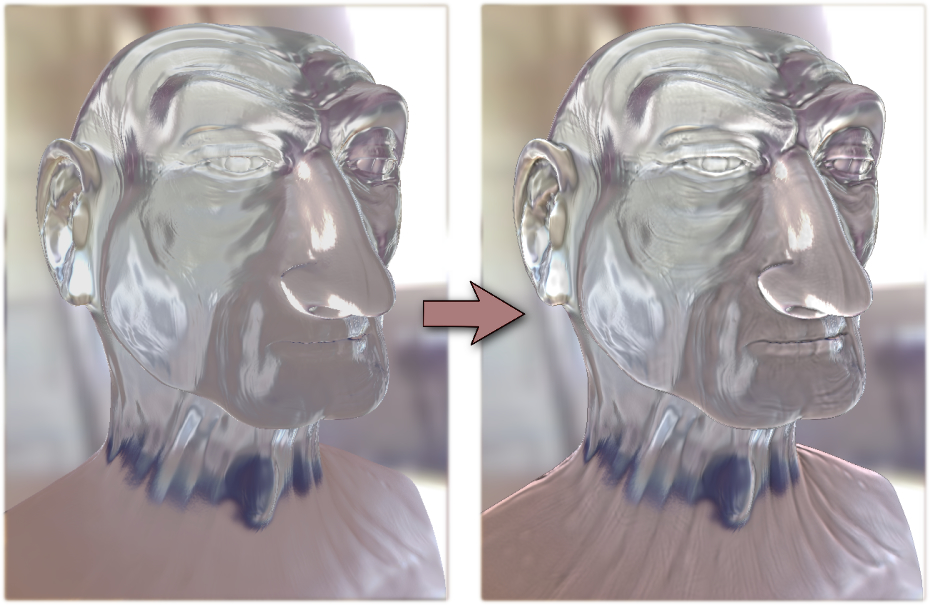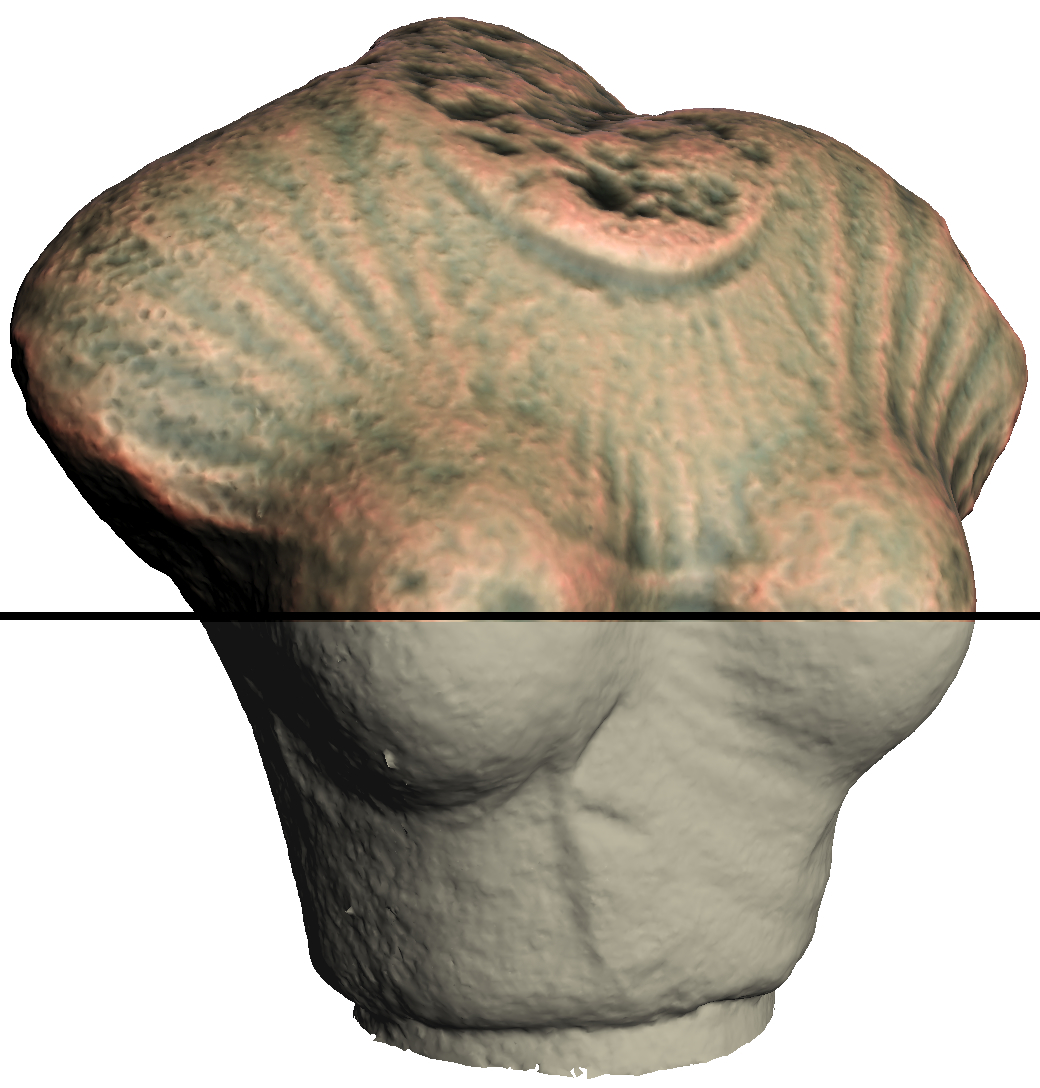Keywords
Computer Science and Digital Science
- A5. Interaction, multimedia and robotics
- A5.1.1. Engineering of interactive systems
- A5.1.6. Tangible interfaces
- A5.3.5. Computational photography
- A5.4. Computer vision
- A5.4.4. 3D and spatio-temporal reconstruction
- A5.5. Computer graphics
- A5.5.1. Geometrical modeling
- A5.5.2. Rendering
- A5.5.3. Computational photography
- A5.5.4. Animation
- A5.6. Virtual reality, augmented reality
- A6.2.3. Probabilistic methods
- A6.2.5. Numerical Linear Algebra
- A6.2.6. Optimization
- A6.2.8. Computational geometry and meshes
Other Research Topics and Application Domains
- B5. Industry of the future
- B5.1. Factory of the future
- B9. Society and Knowledge
- B9.2. Art
- B9.2.2. Cinema, Television
- B9.2.3. Video games
- B9.6. Humanities
- B9.6.6. Archeology, History
- B9.6.10. Digital humanities
1 Team members, visitors, external collaborators
Research Scientists
- Pascal Barla [Team leader, Inria, Researcher, HDR]
- Gaël Guennebaud [Inria, Researcher]
- Romain Pacanowski [Inria, Researcher]
Faculty Members
- Pierre Bénard [Univ de Bordeaux, Associate Professor]
- Patrick Reuter [Univ de Bordeaux, Associate Professor, HDR]
Post-Doctoral Fellow
- David Murray [Institut d'optique graduate school]
PhD Students
- Megane Bati [Institut d'optique graduate school]
- Camille Brunel [Inria, until Jun 2021]
- Corentin Cou [CNRS]
- Melvin Even [Inria, from Oct 2021]
- Gary Fourneau [Inria, from Oct 2021]
- Simon Lucas [Univ de Bordeaux, from Oct 2021]
- Charlie Schlick [Univ de Bordeaux]
Technical Staff
- Marjorie Paillet [Inria, Engineer, from Nov 2021]
Interns and Apprentices
- Melvin Even [Inria, from Feb 2021 until Jul 2021]
- Pierre Hubert-Brierre [École Normale Supérieure de Lyon, from May 2021 until Jul 2021]
- Eliane Schwindenhammer [Inria, from Feb 2021 until Aug 2021]
Administrative Assistant
- Anne-Laure Gautier [Inria]
Visiting Scientist
- Arthur Couturier [Institut national de recherche pour l'agriculture, l'alimentation et l'environnement, from May 2021 until Jul 2021]
External Collaborator
- Xavier Granier [Univ Paris-Saclay, HDR]
2 Overall objectives
2.1 General Introduction
Computer generated images are ubiquitous in our everyday life. Such images are the result of a process that has seldom changed over the years: the optical phenomena due to the propagation of light in a 3D environment are simulated taking into account how light is scattered 46, 23 according to shape and material characteristics of objects. The intersection of optics (for the underlying laws of physics) and computer science (for its modeling and computational efficiency aspects) provides a unique opportunity to tighten the links between these domains in order to first improve the image generation process (computer graphics, optics and virtual reality) and next to develop new acquisition and display technologies (optics, mixed reality and machine vision).
Most of the time, light, shape, and matter properties are studied, acquired, and modeled separately, relying on realistic or stylized rendering processes to combine them in order to create final pixel colors. Such modularity, inherited from classical physics, has the practical advantage of permitting to reuse the same models in various contexts. However, independent developments lead to un-optimized pipelines and difficult-to-control solutions since it is often not clear which part of the expected result is caused by which property. Indeed, the most efficient solutions are most often the ones that blur the frontiers between light, shape, and matter to lead to specialized and optimized pipelines, as in real-time applications (like Bidirectional Texture Functions 56 and Light-Field rendering 21). Keeping these three properties separated may lead to other problems. For instance:
- Measured materials are too detailed to be usable in rendering systems and data reduction techniques have to be developed 55, 57, leading to an inefficient transfer between real and digital worlds;
- It is currently extremely challenging (if not impossible) to directly control or manipulate the interactions between light, shape, and matter. Accurate lighting processes may create solutions that do not fulfill users' expectations;
- Artists can spend hours and days in modeling highly complex surfaces whose details will not be visible 77 due to inappropriate use of certain light sources or reflection properties.
Most traditional applications target human observers. Depending on how deep we take into account the specificity of each user, the requirement of representations, and algorithms may differ.
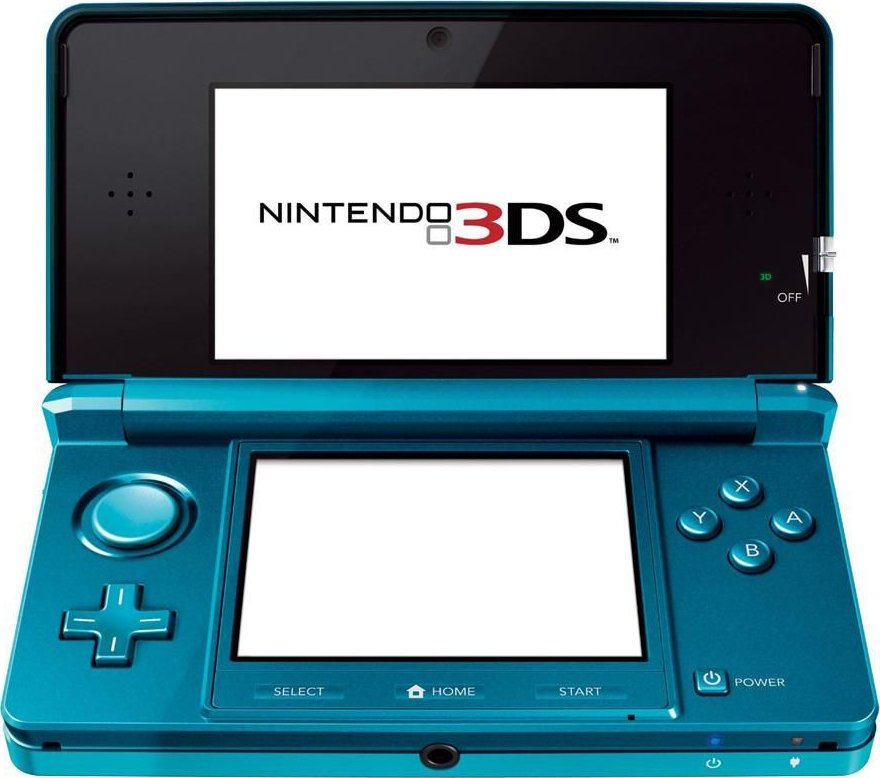
|
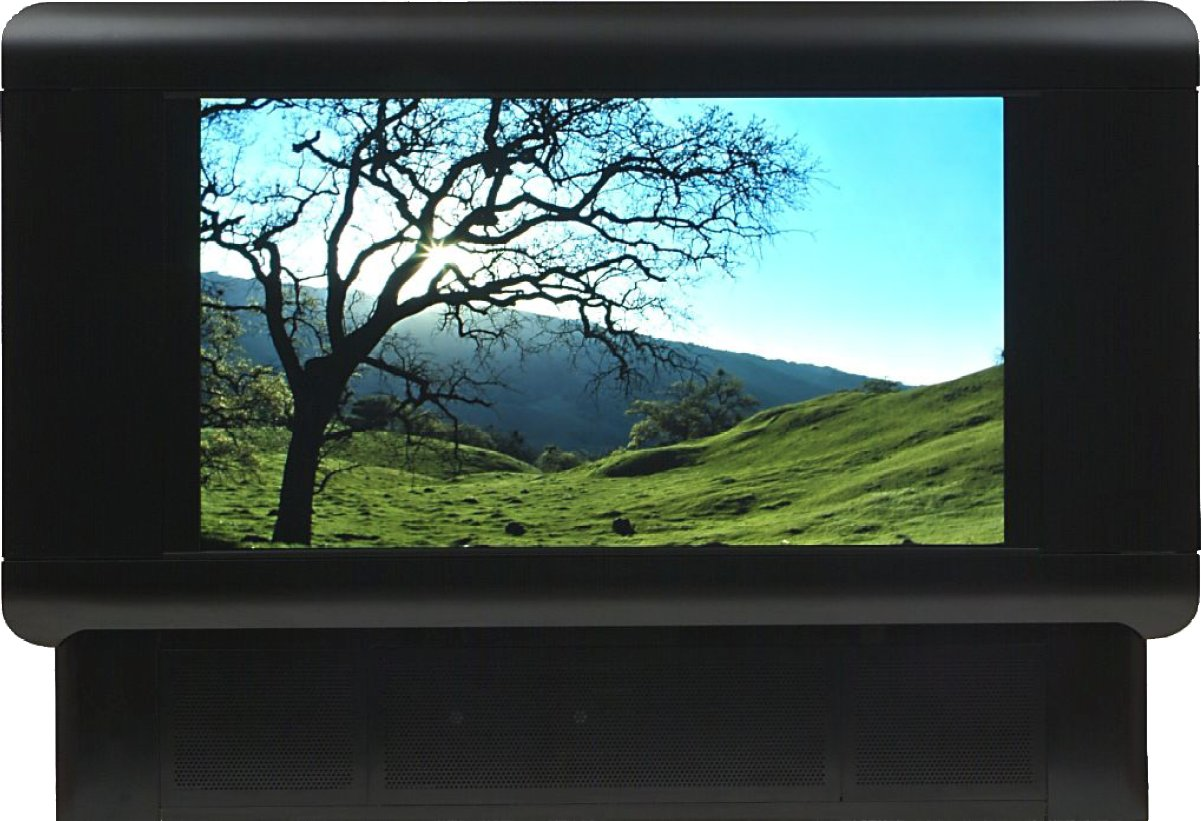
|

|
| Auto-stereoscopy display | HDR display | Printing both geometry and material |
| ©Nintendo | ©Dolby Digital | 38 |
With the evolution of measurement and display technologies that go beyond conventional images (e.g., as illustrated in Figure 1, High-Dynamic Range Imaging 67, stereo displays or new display technologies 42, and physical fabrication 13, 30, 38) the frontiers between real and virtual worlds are vanishing 26. In this context, a sensor combined with computational capabilities may also be considered as another kind of observer. Creating separate models for light, shape, and matter for such an extended range of applications and observers is often inefficient and sometimes provides unexpected results. Pertinent solutions must be able to take into account properties of the observer (human or machine) and application goals.
2.2 Methodology

2.2.1 Using a global approach
The main goal of the MANAO project is to study phenomena resulting from the interactions between the three components that describe light propagation and scattering in a 3D environment: light, shape, and matter. Improving knowledge about these phenomena facilitates the adaption of the developed digital, numerical, and analytic models to specific contexts. This leads to the development of new analysis tools, new representations, and new instruments for acquisition, visualization, and display.
To reach this goal, we have to first increase our understanding of the different phenomena resulting from the interactions between light, shape, and matter. For this purpose, we consider how they are captured or perceived by the final observer, taking into account the relative influence of each of the three components. Examples include but are not limited to:
- The manipulation of light to reveal reflective 18 or geometric properties 84, as mastered by professional photographers;
- The modification of material characteristics or lighting conditions 83 to better understand shape features, for instance to decipher archaeological artifacts;
- The large influence of shape on the captured variation of shading 65 and thus on the perception of material properties 80.
Based on the acquired knowledge of the influence of each of the components, we aim at developing new models that combine two or three of these components. Examples include the modeling of Bidirectional Texture Functions (BTFs) 29 that encode in a unique representation effects of parallax, multiple light reflections, and also shadows without requiring to store separately the reflective properties and the meso-scale geometric details, or Light-Fields that are used to render 3D scenes by storing only the result of the interactions between light, shape, and matter both in complex real environments and in simulated ones.
One of the strengths of MANAO is that we are inter-connecting computer graphics and optics (Figure 2). On one side, the laws of physics are required to create images but may be bent to either increase performance or user's control: this is one of the key advantage of computer graphics approach. It is worth noticing that what is not possible in the real world may be possible in a digital world. However, on the other side, the introduced approximations may help to better comprehend the physical interactions of light, shape, and matter.
2.2.2 Taking observers into account
The MANAO project specifically aims at considering information transfer, first from the real world to the virtual world (acquisition and creation), then from computers to observers (visualization and display). For this purpose, we use a larger definition of what an observer is: it may be a human user or a physical sensor equipped with processing capabilities. Sensors and their characteristics must be taken into account in the same way as we take into account the human visual system in computer graphics. Similarly, computational capabilities may be compared to cognitive capabilities of human users. Some characteristics are common to all observers, such as the scale of observed phenomena. Some others are more specifics to a set of observers. For this purpose, we have identified two classes of applications.
- Physical systems Provided our partnership that leads to close relationships with optics, one novelty of our approach is to extend the range of possible observers to physical sensors in order to work on domains such as simulation, mixed reality, and testing. Capturing, processing, and visualizing complex data is now more and more accessible to everyone, leading to the possible convergence of real and virtual worlds through visual signals. This signal is traditionally captured by cameras. It is now possible to augment them by projecting (e.g., the infrared laser of Microsoft Kinect) and capturing (e.g., GPS localization) other signals that are outside the visible range. These supplemental information replace values traditionally extracted from standard images and thus lower down requirements in computational power 53. Since the captured images are the result of the interactions between light, shape, and matter, the approaches and the improved knowledge from MANAO help in designing interactive acquisition and rendering technologies that are required to merge the real and the virtual world. With the resulting unified systems (optical and digital), transfer of pertinent information is favored and inefficient conversion is likely avoided, leading to new uses in interactive computer graphics applications, like augmented reality 17, 26 and computational photography 66.
- Interactive visualization This direction includes domains such as scientific illustration and visualization, artistic or plausible rendering. In all these cases, the observer, a human, takes part in the process, justifying once more our focus on real-time methods. When targeting average users, characteristics as well as limitations of the human visual system should be taken into account: in particular, it is known that some configurations of light, shape, and matter have masking and facilitation effects on visual perception 77. For specialized applications, the expertise of the final user and the constraints for 3D user interfaces lead to new uses and dedicated solutions for models and algorithms.
3 Research program
3.1 Related Scientific Domains

The MANAO project aims at studying, acquiring, modeling, and rendering the interactions between the three components that are light, shape, and matter from the viewpoint of an observer. As detailed more lengthily in the next section, such a work will be done using the following approach: first, we will tend to consider that these three components do not have strict frontiers when considering their impacts on the final observers; then, we will not only work in computer graphics, but also at the intersection of computer graphics and optics, exploring the mutual benefits that the two domains may provide. It is thus intrinsically a transdisciplinary project (as illustrated in Figure 3) and we expect results in both domains.
Thus, the proposed team-project aims at establishing a close collaboration between computer graphics (e.g., 3D modeling, geometry processing, shading techniques, vector graphics, and GPU programming) and optics (e.g., design of optical instruments, and theories of light propagation). The following examples illustrate the strengths of such a partnership. First, in addition to simpler radiative transfer equations 31 commonly used in computer graphics, research in the later will be based on state-of-the-art understanding of light propagation and scattering in real environments. Furthermore, research will rely on appropriate instrumentation expertise for the measurement 43, 44 and display 42 of the different phenomena. Reciprocally, optics researches may benefit from the expertise of computer graphics scientists on efficient processing to investigate interactive simulation, visualization, and design. Furthermore, new systems may be developed by unifying optical and digital processing capabilities. Currently, the scientific background of most of the team members is related to computer graphics and computer vision. A large part of their work have been focused on simulating and analyzing optical phenomena as well as in acquiring and visualizing them. Combined with the close collaboration with the optics laboratory LP2N and with the students issued from the “Institut d'Optique”, this background ensures that we can expect the following results from the project: the construction of a common vocabulary for tightening the collaboration between the two scientific domains and creating new research topics. By creating this context, we expect to attract (and even train) more trans-disciplinary researchers.
At the boundaries of the MANAO project lie issues in human and machine vision. We have to deal with the former whenever a human observer is taken into account. On one side, computational models of human vision are likely to guide the design of our algorithms. On the other side, the study of interactions between light, shape, and matter may shed some light on the understanding of visual perception. The same kind of connections are expected with machine vision. On the one hand, traditional computational methods for acquisition (such as photogrammetry) are going to be part of our toolbox. On the other hand, new display technologies (such as the ones used for augmented reality) are likely to benefit from our integrated approach and systems. In the MANAO project we are mostly users of results from human vision. When required, some experimentation might be done in collaboration with experts from this domain, like with the European PRISM project. For machine vision, provided the tight collaboration between optical and digital systems, research will be carried out inside the MANAO project.
Analysis and modeling rely on tools from applied mathematics such as differential and projective geometry, multi-scale models, frequency analysis 33 or differential analysis 65, linear and non-linear approximation techniques, stochastic and deterministic integrations, and linear algebra. We not only rely on classical tools, but also investigate and adapt recent techniques (e.g., improvements in approximation techniques), focusing on their ability to run on modern hardware: the development of our own tools (such as Eigen) is essential to control their performances and their abilities to be integrated into real-time solutions or into new instruments.
3.2 Research axes
The MANAO project is organized around four research axes that cover the large range of expertise of its members and associated members. We briefly introduce these four axes in this section. More details and their inter-influences that are illustrated in the Figure 2 will be given in the following sections.
Axis 1 is the theoretical foundation of the project. Its main goal is to increase the understanding of light, shape, and matter interactions by combining expertise from different domains: optics and human/machine vision for the analysis and computer graphics for the simulation aspect. The goal of our analyses is to identify the different layers/phenomena that compose the observed signal. In a second step, the development of physical simulations and numerical models of these identified phenomena is a way to validate the pertinence of the proposed decompositions.
In Axis 2, the final observers are mainly physical captors. Our goal is thus the development of new acquisition and display technologies that combine optical and digital processes in order to reach fast transfers between real and digital worlds, in order to increase the convergence of these two worlds.
Axes 3 and 4 focus on two aspects of computer graphics: rendering, visualization and illustration in Axis 3, and editing and modeling (content creation) in Axis 4. In these two axes, the final observers are mainly human users, either generic users or expert ones (e.g., archaeologist 69, computer graphics artists).
3.3 Axis 1: Analysis and Simulation
Challenge: Definition and understanding of phenomena resulting from interactions between light, shape, and matter as seen from an observer point of view.
Results: Theoretical tools and numerical models for analyzing and simulating the observed optical phenomena.
To reach the goals of the MANAO project, we need to increase our understanding of how light, shape, and matter act together in synergy and how the resulting signal is finally observed. For this purpose, we need to identify the different phenomena that may be captured by the targeted observers. This is the main objective of this research axis, and it is achieved by using three approaches: the simulation of interactions between light, shape, and matter, their analysis and the development of new numerical models. This resulting improved knowledge is a foundation for the researches done in the three other axes, and the simulation tools together with the numerical models serve the development of the joint optical/digital systems in Axis 2 and their validation.
One of the main and earliest goals in computer graphics is to faithfully reproduce the real world, focusing mainly on light transport. Compared to researchers in physics, researchers in computer graphics rely on a subset of physical laws (mostly radiative transfer and geometric optics), and their main concern is to efficiently use the limited available computational resources while developing as fast as possible algorithms. For this purpose, a large set of theoretical as well as computational tools has been introduced to take a maximum benefit of hardware specificities. These tools are often dedicated to specific phenomena (e.g., direct or indirect lighting, color bleeding, shadows, caustics). An efficiency-driven approach needs such a classification of light paths 39 in order to develop tailored strategies 81. For instance, starting from simple direct lighting, more complex phenomena have been progressively introduced: first diffuse indirect illumination 37, 73, then more generic inter-reflections 46, 31 and volumetric scattering 70, 28. Thanks to this search for efficiency and this classification, researchers in computer graphics have developed a now recognized expertise in fast-simulation of light propagation. Based on finite elements (radiosity techniques) or on unbiased Monte Carlo integration schemes (ray-tracing, particle-tracing, ...), the resulting algorithms and their combination are now sufficiently accurate to be used-back in physical simulations. The MANAO project will continue the search for efficient and accurate simulation techniques, but extending it from computer graphics to optics. Thanks to the close collaboration with scientific researchers from optics, new phenomena beyond radiative transfer and geometric optics will be explored.
Search for algorithmic efficiency and accuracy has to be done in parallel with numerical models. The goal of visual fidelity (generalized to accuracy from an observer point of view in the project) combined with the goal of efficiency leads to the development of alternative representations. For instance, common classical finite-element techniques compute only basis coefficients for each discretization element: the required discretization density would be too large and to computationally expensive to obtain detailed spatial variations and thus visual fidelity. Examples includes texture for decorrelating surface details from surface geometry and high-order wavelets for a multi-scale representation of lighting 27. The numerical complexity explodes when considering directional properties of light transport such as radiance intensity (Watt per square meter and per steradian - ), reducing the possibility to simulate or accurately represent some optical phenomena. For instance, Haar wavelets have been extended to the spherical domain 72 but are difficult to extend to non-piecewise-constant data 75. More recently, researches prefer the use of Spherical Radial Basis Functions 78 or Spherical Harmonics 64. For more complex data, such as reflective properties (e.g., BRDF 58, 47 - 4D), ray-space (e.g., Light-Field 54 - 4D), spatially varying reflective properties (6D - 68), new models, and representations are still investigated such as rational functions 61 or dedicated models 15 and parameterizations 71, 76. For each (newly) defined phenomena, we thus explore the space of possible numerical representations to determine the most suited one for a given application, like we have done for BRDF 61.
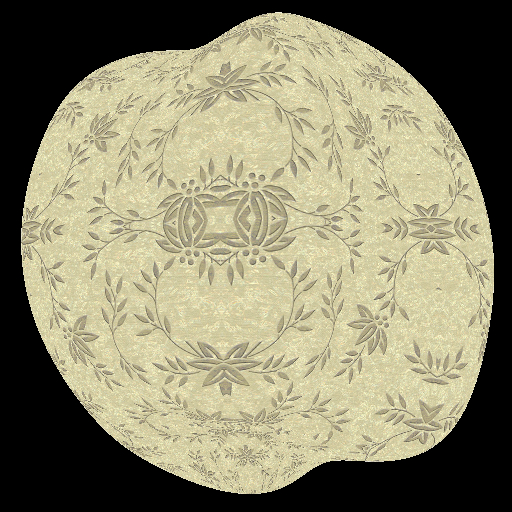
|
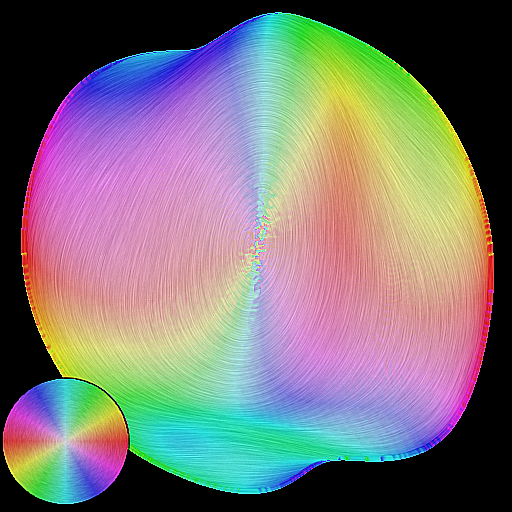
|
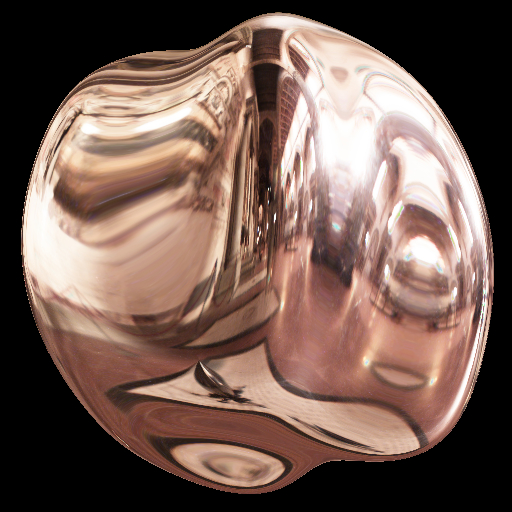
|
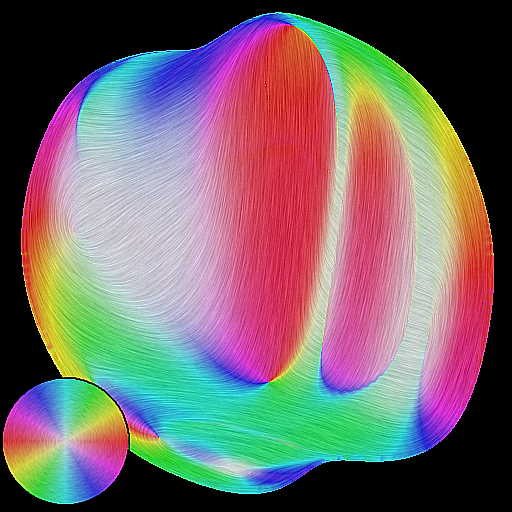
|
| Texuring | 1st order gradient field | Environment reflection | 2st order gradient field |
Before being able to simulate or to represent the different observed phenomena, we need to define and describe them. To understand the difference between an observed phenomenon and the classical light, shape, and matter decomposition, we can take the example of a highlight. Its observed shape (by a human user or a sensor) is the resulting process of the interaction of these three components, and can be simulated this way. However, this does not provide any intuitive understanding of their relative influence on the final shape: an artist will directly describe the resulting shape, and not each of the three properties. We thus want to decompose the observed signal into models for each scale that can be easily understandable, representable, and manipulable. For this purpose, we will rely on the analysis of the resulting interaction of light, shape, and matter as observed by a human or a physical sensor. We first consider this analysis from an optical point of view, trying to identify the different phenomena and their scale according to their mathematical properties (e.g., differential 65 and frequency analysis 33). Such an approach has leaded us to exhibit the influence of surfaces flows (depth and normal gradients) into lighting pattern deformation (see Figure 4). For a human observer, this correspond to one recent trend in computer graphics that takes into account the human visual systems 34 both to evaluate the results and to guide the simulations.
3.4 Axis 2: From Acquisition to Display
Challenge: Convergence of optical and digital systems to blend real and virtual worlds.
Results: Instruments to acquire real world, to display virtual world, and to make both of them interact.
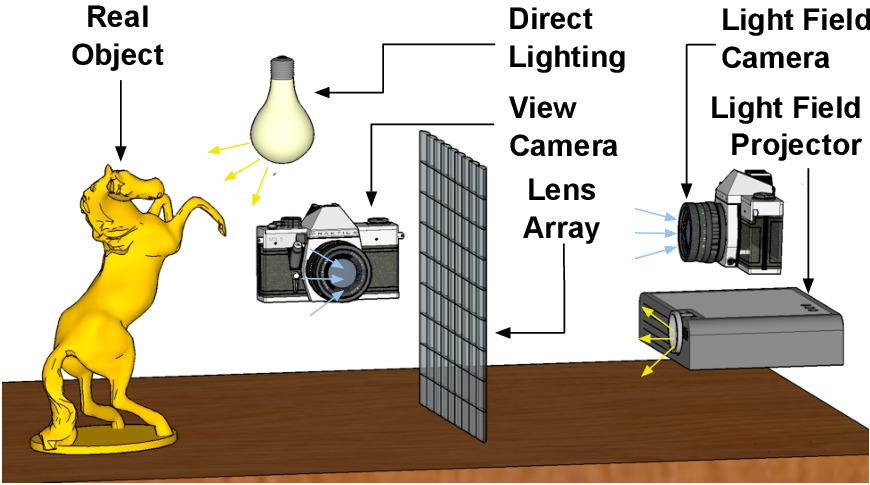
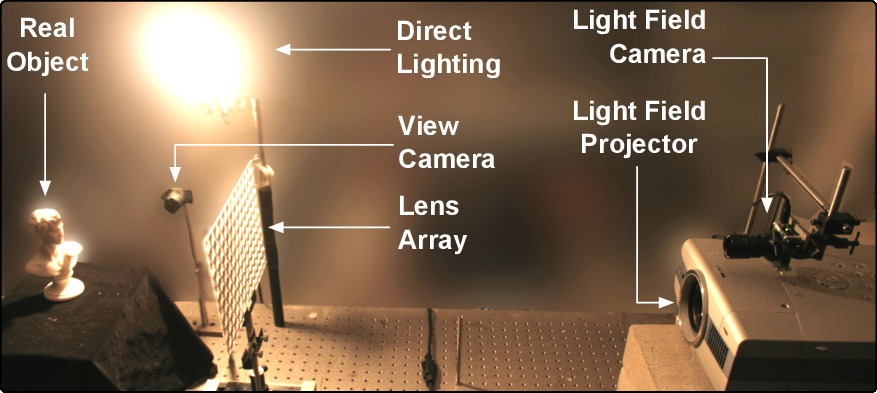
In this axis, we investigate unified acquisition and display systems, that is systems which combine optical instruments with digital processing. From digital to real, we investigate new display approaches 54, 42. We consider projecting systems and surfaces 22, for personal use, virtual reality and augmented reality 17. From the real world to the digital world, we favor direct measurements of parameters for models and representations, using (new) optical systems unless digitization is required 36, 35. These resulting systems have to acquire the different phenomena described in Axis 1 and to display them, in an efficient manner 40, 16, 41, 44. By efficient, we mean that we want to shorten the path between the real world and the virtual world by increasing the data bandwidth between the real (analog) and the virtual (digital) worlds, and by reducing the latency for real-time interactions (we have to prevent unnecessary conversions, and to reduce processing time). To reach this goal, the systems have to be designed as a whole, not by a simple concatenation of optical systems and digital processes, nor by considering each component independently 45.
To increase data bandwidth, one solution is to parallelize more and more the physical systems. One possible solution is to multiply the number of simultaneous acquisitions (e.g., simultaneous images from multiple viewpoints 44, 63). Similarly, increasing the number of viewpoints is a way toward the creation of full 3D displays 54. However, full acquisition or display of 3D real environments theoretically requires a continuous field of viewpoints, leading to huge data size. Despite the current belief that the increase of computational power will fill the missing gap, when it comes to visual or physical realism, if you double the processing power, people may want four times more accuracy, thus increasing data size as well. To reach the best performances, a trade-off has to be found between the amount of data required to represent accurately the reality and the amount of required processing. This trade-off may be achieved using compressive sensing. Compressive sensing is a new trend issued from the applied mathematics community that provides tools to accurately reconstruct a signal from a small set of measurements assuming that it is sparse in a transform domain (e.g., 62, 87).
We prefer to achieve this goal by avoiding as much as possible the classical approach where acquisition is followed by a fitting step: this requires in general a large amount of measurements and the fitting itself may consume consequently too much memory and preprocessing time. By preventing unnecessary conversion through fitting techniques, such an approach increase the speed and reduce the data transfer for acquisition but also for display. One of the best recent examples is the work of Cossairt et al. 26. The whole system is designed around a unique representation of the energy-field issued from (or leaving) a 3D object, either virtual or real: the Light-Field. A Light-Field encodes the light emitted in any direction from any position on an object. It is acquired thanks to a lens-array that leads to the capture of, and projection from, multiple simultaneous viewpoints. A unique representation is used for all the steps of this system. Lens-arrays, parallax barriers, and coded-aperture 52 are one of the key technologies to develop such acquisition (e.g., Light-Field camera 1 45 and acquisition of light-sources 36), projection systems (e.g., auto-stereoscopic displays). Such an approach is versatile and may be applied to improve classical optical instruments 50. More generally, by designing unified optical and digital systems 59, it is possible to leverage the requirement of processing power, the memory footprint, and the cost of optical instruments.
Those are only some examples of what we investigate. We also consider the following approaches to develop new unified systems. First, similar to (and based on) the analysis goal of Axis 1, we have to take into account as much as possible the characteristics of the measurement setup. For instance, when fitting cannot be avoided, integrating them may improve both the processing efficiency and accuracy 61. Second, we have to integrate signals from multiple sensors (such as GPS, accelerometer, ...) to prevent some computation (e.g., 53). Finally, the experience of the group in surface modeling help the design of optical surfaces 48 for light sources or head-mounted displays.
3.5 Axis 3: Rendering, Visualization and Illustration
Challenge: How to offer the most legible signal to the final observer in real-time?
Results: High-level shading primitives, expressive rendering techniques for object depiction, real-time realistic rendering algorithms
The main goal of this axis is to offer to the final observer, in this case mostly a human user, the most legible signal in real-time. Thanks to the analysis and to the decomposition in different phenomena resulting from interactions between light, shape, and matter (Axis 1), and their perception, we can use them to convey essential information in the most pertinent way. Here, the word pertinent can take various forms depending on the application.
In the context of scientific illustration and visualization, we are primarily interested in tools to convey shape or material characteristics of objects in animated 3D scenes. Expressive rendering techniques (see Figure 6c,d) provide means for users to depict such features with their own style. To introduce our approach, we detail it from a shape-depiction point of view, domain where we have acquired a recognized expertise. Prior work in this area mostly focused on stylization primitives to achieve line-based rendering 85, 49 or stylized shading 20, 83 with various levels of abstraction. A clear representation of important 3D object features remains a major challenge for better shape depiction, stylization and abstraction purposes. Most existing representations provide only local properties (e.g., curvature), and thus lack characterization of broader shape features. To overcome this limitation, we are developing higher level descriptions of shape 14 with increased robustness to sparsity, noise, and outliers. This is achieved in close collaboration with Axis 1 by the use of higher-order local fitting methods, multi-scale analysis, and global regularization techniques. In order not to neglect the observer and the material characteristics of the objects, we couple this approach with an analysis of the appearance model. To our knowledge, this is an approach which has not been considered yet. This research direction is at the heart of the MANAO project, and has a strong connection with the analysis we plan to conduct in Axis 1. Material characteristics are always considered at the light ray level, but an understanding of higher-level primitives (like the shape of highlights and their motion) would help us to produce more legible renderings and permit novel stylizations; for instance, there is no method that is today able to create stylized renderings that follow the motion of highlights or shadows. We also believe such tools also play a fundamental role for geometry processing purposes (such as shape matching, reassembly, simplification), as well as for editing purposes as discussed in Axis 4.
In the context of real-time photo-realistic rendering ((see Figure 6a,b), the challenge is to compute the most plausible images with minimal effort. During the last decade, a lot of work has been devoted to design approximate but real-time rendering algorithms of complex lighting phenomena such as soft-shadows 86, motion blur 33, depth of field 74, reflexions, refractions, and inter-reflexions. For most of these effects it becomes harder to discover fundamentally new and faster methods. On the other hand, we believe that significant speedup can still be achieved through more clever use of massively parallel architectures of the current and upcoming hardware, and/or through more clever tuning of the current algorithms. In particular, regarding the second aspect, we remark that most of the proposed algorithms depend on several parameters which can be used to trade the speed over the quality. Significant speed-up could thus be achieved by identifying effects that would be masked or facilitated and thus devote appropriate computational resources to the rendering 51, 32. Indeed, the algorithm parameters controlling the quality vs speed are numerous without a direct mapping between their values and their effect. Moreover, their ideal values vary over space and time, and to be effective such an auto-tuning mechanism has to be extremely fast such that its cost is largely compensated by its gain. We believe that our various work on the analysis of the appearance such as in Axis 1 could be beneficial for such purpose too.
Realistic and real-time rendering is closely related to Axis 2: real-time rendering is a requirement to close the loop between real world and digital world. We have to thus develop algorithms and rendering primitives that allow the integration of the acquired data into real-time techniques. We have also to take care of that these real-time techniques have to work with new display systems. For instance, stereo, and more generally multi-view displays are based on the multiplication of simultaneous images. Brute force solutions consist in independent rendering pipeline for each viewpoint. A more energy-efficient solution would take advantages of the computation parts that may be factorized. Another example is the rendering techniques based on image processing, such as our work on augmented reality 24. Independent image processing for each viewpoint may disturb the feeling of depth by introducing inconsistent information in each images. Finally, more dedicated displays 42 would require new rendering pipelines.
3.6 Axis 4: Editing and Modeling
Challenge: Editing and modeling appearance using drawing- or sculpting-like tools through high level representations.
Results: High-level primitives and hybrid representations for appearance and shape.
During the last decade, the domain of computer graphics has exhibited tremendous improvements in image quality, both for 2D applications and 3D engines. This is mainly due to the availability of an ever increasing amount of shape details, and sophisticated appearance effects including complex lighting environments. Unfortunately, with such a growth in visual richness, even so-called vectorial representations (e.g., subdivision surfaces, Bézier curves, gradient meshes, etc.) become very dense and unmanageable for the end user who has to deal with a huge mass of control points, color labels, and other parameters. This is becoming a major challenge, with a necessity for novel representations. This Axis is thus complementary of Axis 3: the focus is the development of primitives that are easy to use for modeling and editing.
More specifically, we plan to investigate vectorial representations that would be amenable to the production of rich shapes with a minimal set of primitives and/or parameters. To this end we plan to build upon our insights on dynamic local reconstruction techniques and implicit surfaces 2519. When working in 3D, an interesting approach to produce detailed shapes is by means of procedural geometry generation. For instance, many natural phenomena like waves or clouds may be modeled using a combination of procedural functions. Turning such functions into triangle meshes (main rendering primitives of GPUs) is a tedious process that appears not to be necessary with an adapted vectorial shape representation where one could directly turn procedural functions into implicit geometric primitives. Since we want to prevent unnecessary conversions in the whole pipeline (here, between modeling and rendering steps), we will also consider hybrid representations mixing meshes and implicit representations. Such research has thus to be conducted while considering the associated editing tools as well as performance issues. It is indeed important to keep real-time performance (cf. Axis 2) throughout the interaction loop, from user inputs to display, via editing and rendering operations. Finally, it would be interesting to add semantic information into 2D or 3D geometric representations. Semantic geometry appears to be particularly useful for many applications such as the design of more efficient manipulation and animation tools, for automatic simplification and abstraction, or even for automatic indexing and searching. This constitutes a complementary but longer term research direction.
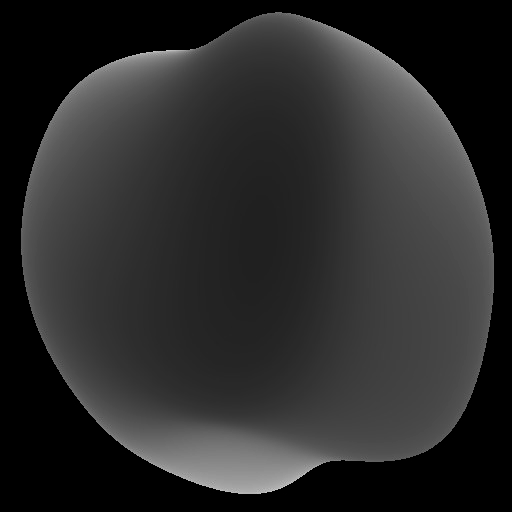
|
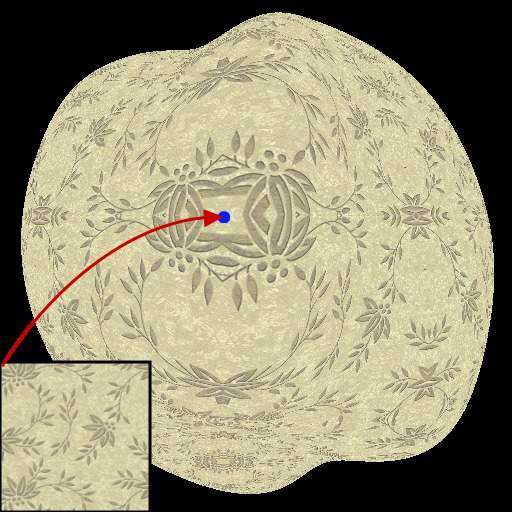
|

|
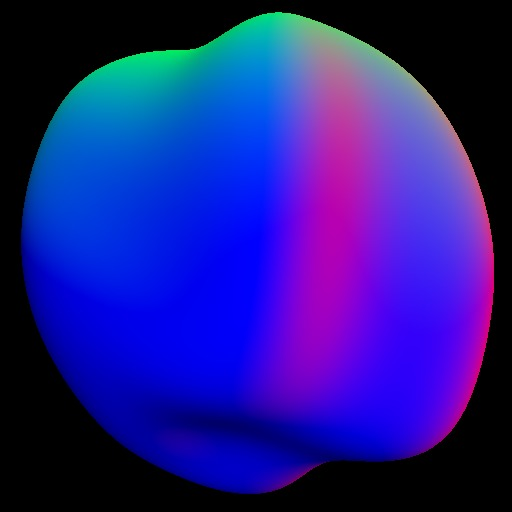
|
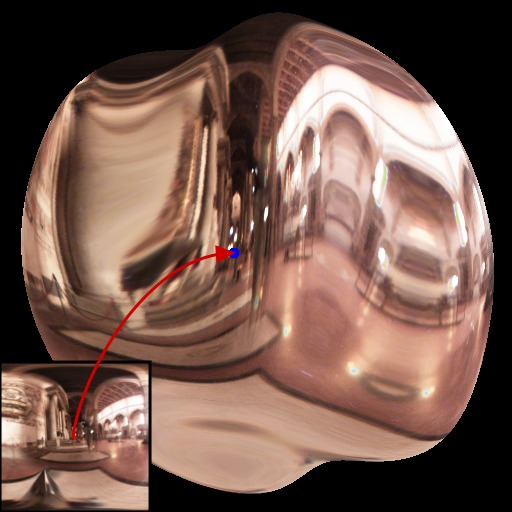
|
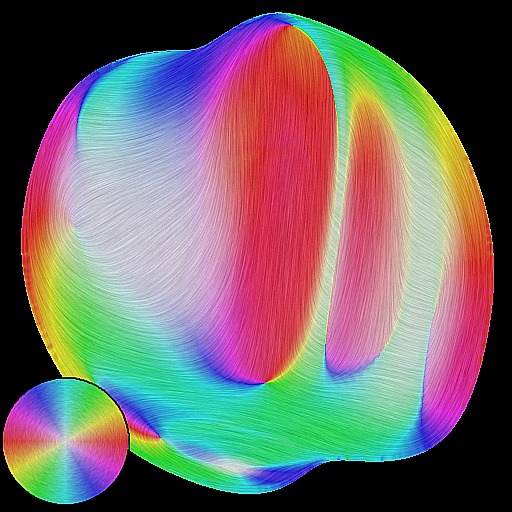
|
| (a) | (b) | (c) | (d) | (e) | (f) |
In the MANAO project, we want to investigate representations beyond the classical light, shape, and matter decomposition. We thus want to directly control the appearance of objects both in 2D and 3D applications (e.g., 79): this is a core topic of computer graphics. When working with 2D vector graphics, digital artists must carefully set up color gradients and textures: examples range from the creation of 2D logos to the photo-realistic imitation of object materials. Classic vector primitives quickly become impractical for creating illusions of complex materials and illuminations, and as a result an increasing amount of time and skill is required. This is only for still images. For animations, vector graphics are only used to create legible appearances composed of simple lines and color gradients. There is thus a need for more complex primitives that are able to accommodate complex reflection or texture patterns, while keeping the ease of use of vector graphics. For instance, instead of drawing color gradients directly, it is more advantageous to draw flow lines that represent local surface concavities and convexities. Going through such an intermediate structure then allows to deform simple material gradients and textures in a coherent way (see Figure 7), and animate them all at once. The manipulation of 3D object materials also raises important issues. Most existing material models are tailored to faithfully reproduce physical behaviors, not to be easily controllable by artists. Therefore artists learn to tweak model parameters to satisfy the needs of a particular shading appearance, which can quickly become cumbersome as the complexity of a 3D scene increases. We believe that an alternative approach is required, whereby material appearance of an object in a typical lighting environment is directly input (e.g., painted or drawn), and adapted to match a plausible material behavior. This way, artists will be able to create their own appearance (e.g., by using our shading primitives 79), and replicate it to novel illumination environments and 3D models. For this purpose, we will rely on the decompositions and tools issued from Axis 1.
4 Application domains
4.1 Physical Systems
Given our close relationships with researchers in optics, one novelty of our approach is to extend the range of possible observers to physical sensors in order to work on domains such as simulation, mixed reality, and testing. Capturing, processing, and visualizing complex data is now more and more accessible to everyone, leading to the possible convergence of real and virtual worlds through visual signals. This signal is traditionally captured by cameras. It is now possible to augment them by projecting (e.g., the infrared laser of Microsoft Kinect) and capturing (e.g., GPS localization) other signals that are outside the visible range. This supplemental information replaces values traditionally extracted from standard images and thus lowers down requirements in computational power. Since the captured images are the result of the interactions between light, shape, and matter, the approaches and the improved knowledge from MANAO help in designing interactive acquisition and rendering technologies that are required to merge the real and the virtual worlds. With the resulting unified systems (optical and digital), transfer of pertinent information is favored and inefficient conversion is likely avoided, leading to new uses in interactive computer graphics applications, like augmented reality, displays and computational photography.
4.2 Interactive Visualization and Modeling
This direction includes domains such as scientific illustration and visualization, artistic or plausible rendering, and 3D modeling. In all these cases, the observer, a human, takes part in the process, justifying once more our focus on real-time methods. When targeting average users, characteristics as well as limitations of the human visual system should be taken into account: in particular, it is known that some configurations of light, shape, and matter have masking and facilitation effects on visual perception. For specialized applications (such as archeology), the expertise of the final user and the constraints for 3D user interfaces lead to new uses and dedicated solutions for models and algorithms.
5 Social and environmental responsibility
5.1 Footprint of research activities
For a few years now, our team has been collectively carefull in limiting its direct environmental impacts, mainly by limiting the number of flights and extending the lifetime of PCs and laptops beyong the warranty period.
5.2 Environmental involvement
Gaël Guennebaud and Pascal Barla are engaged in several actions and initiatives related to the environmental issues, both within Inria itself, and within the research and higher-education domain in general:
- They are members of the “Local Sustainable Development Committee” of Inria Bordeaux.
- They are animators of the “The Climate Fresk”.
- G. Guennebaud is a member of the “Social and Environmental Responsibility Committee” of the LaBRI and of the “transition network” of the University of Bordeaux.
- At the Inria's national level, G. Guennebaud is part of two working groups on the reduction of the footprint of professional travels and computer devices respectively.
- Ecoinfo: G. Guennebaud is involved within the GDS Ecoinfo of the CNRS, and in particular he is in charge of the developpement of the ecodiag tool among other activities.
- Labo1point5: G. Guennebaud has joined the labo1point5 group, in particular to help with the developpment of a module to take into account the carbon footprint of ICT devices within their carbon footprint estimation tool (GES1point5). The module has been release in October 2021.
- G. Guennebaud has participated in the elaboration and dissemination of a new course, “Introduction to climate change issues and the environnemental impacts of ICT”, with two collegues of the LaBRI.
6 Highlights of the year
We are regularly publishing our work at the prestigious conference Siggraph. This year was particularly successful with two plain papers 7, 6 that are also published in the journal ACM Transactions on Graphics.
7 New software and platforms
7.1 New software
7.1.1 Spectral Viewer
-
Keyword:
Image
-
Functional Description:
An open-source (spectral) image viewer that supports several images formats: ENVI (spectral), exr, png, jpg.
- URL:
-
Authors:
Arthur Dufay, Romain Pacanowski, Pascal Barla, Alban Fichet, David Murray
-
Contact:
Romain Pacanowski
-
Partner:
LP2N (CNRS - UMR 5298)
7.1.2 Malia
-
Name:
The Malia Rendering Framework
-
Keywords:
3D, Realistic rendering, GPU, Ray-tracing, Material appearance
-
Functional Description:
The Malia Rendering Framework is an open source library for predictive, physically-realistic rendering. It comes with several applications, including a spectral path tracer, RGB-to-spectral conversion routines a blender bridge and a spectral image viewer.
- URL:
-
Authors:
Arthur Dufay, Romain Pacanowski, Romain Pacanowski, Pascal Barla, David Murray, David Murray, Alban Fichet
-
Contact:
Romain Pacanowski
7.1.3 FRITE
-
Keywords:
2D animation, Vector-based drawing
-
Functional Description:
2D animation software allowing non linear editing
-
Authors:
Pierre Benard, Pascal Barla
-
Contact:
Pierre Benard
7.1.4 ecodiag
-
Keywords:
CO2, Carbon footprint, Web Services
-
Functional Description:
Ecodiag is a web service to estimate the carbon footprint of the computer equipments.
-
Contact:
Gael Guennebaud
-
Partner:
Ecoinfo
8 New results
8.1 From Acquisition to Display
8.1.1 3D for Studying Reuse in 19th Century Cairo: the Case of Saint-Maurice Residence
Participants: Corentin Cou, Gaël Guennebaud, Romain Pacanowski.
3D restitution is now a well-known tool to validate hypotheses on historical buildings that do not exist anymore. The present project 10 takes the method a step further in order to explore the art historical topic of ornament reuse in 19th century revival architecture, particularly in Cairo. The case study is the Saint-Maurice residence, built 1875-79, for which an extensive collection of documents in varied formats, and from multiple locations and disciplines, has been conducted. The paper presents some preliminary results on the 3D restitution, the remaining open questions and the challenges they raise.
8.2 Rendering, Visualization and Illustration
8.2.1 Coherent Mark-based Stylization of 3D Scenes at the Compositing Stage
Participants: Maxime Garcia [MAVERICK Inria Grenoble - Rhône-Alpes, LJK], Romain Vergne [MAVERICK Inria Grenoble - Rhône-Alpes, LJK], Mohamed-Amine Farhat [MAVERICK Inria Grenoble - Rhône-Alpes, LJK], Pierre Bénard [MAVERICK Inria Grenoble - Rhône-Alpes, LJK], Joëlle Thollot [MAVERICK Inria Grenoble - Rhône-Alpes, LJK].
We present in this paper 9 a novel temporally coherent stylized rendering technique working entirely at the compositing stage. We first generate a distribution of 3D anchor points using an implicit grid based on the local object positions stored in a G-buffer, hence following object motion. We then draw splats in screen space anchored to these points so as to be motion coherent (Figure 8). To increase the perceived flatness of the style, we adjust the anchor points density using a fractalization mechanism. Sudden changes are prevented by controlling the anchor points opacity and introducing a new order-independent blending function. We demonstrate the versatility of our method by showing a large variety of styles thanks to the freedom offered by the splats content and their attributes that can be controlled by any G-buffer.
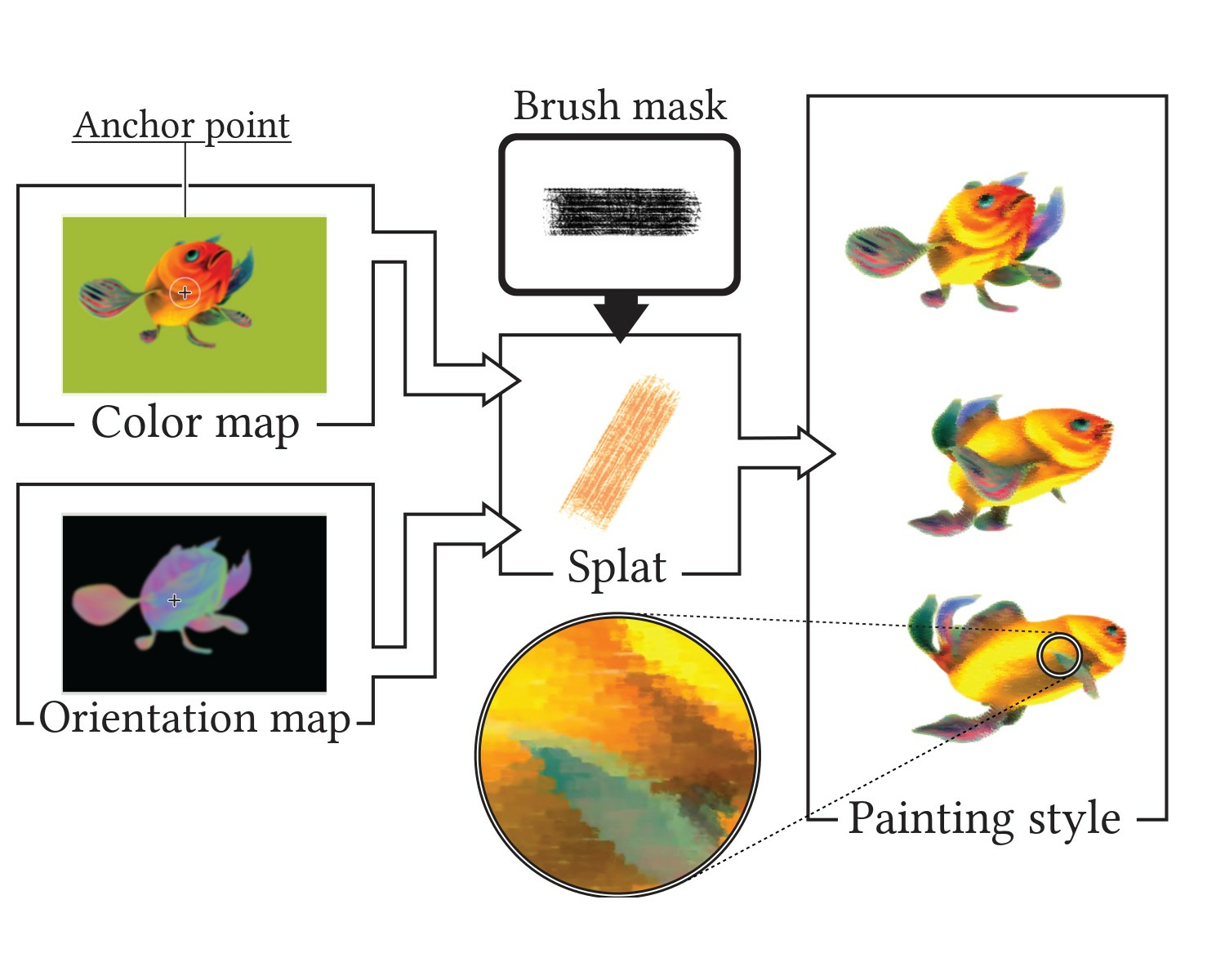
8.3 Editing and Modeling
8.3.1 A Time-independent Deformer for Elastic Contacts
Participants: Camille Brunel, Pierre Bénard, Gaël Guennebaud.
In this article 7, we present a purely geometric, time-independent deformer resolving local contacts between elastic objects, including self-collisions between adjacent parts of the same object that often occur in character skinning animation. Starting from multiple meshes in intersection, our deformer first computes the parts of the surfaces remaining in contact, and then applies a procedural displacement with volume preservation. Although our deformer processes each frame independently, it achieves temporally continuous deformations with artistic control of the bulge through few pseudo-stiffness parameters. The plausibility of the deformation is further enhanced by anisotropically spreading the volume-preserving bulge. The result is a robust, real-time deformer that can handle complex geometric configurations such as a ball squashed by a hand, colliding lips, bending fingers, etc (Figure 9).

8.3.2 An Inverse Method for the Exploration of Layered Material Appearance
Participants: Mégane Bati, Pascal Barla, Romain Pacanowski.
Layered materials exhibit a wide range of appearance, due to the combined effects of absorption and scattering at and between interfaces. Yet most existing approaches let users set the physical parameters of all layers by hand, a process of trial and error. We introduce an inverse method 6 that provides control over BRDF lobe properties of layered materials, while automatically retrieving compatible physical parameters. Our method permits to explore the space of layered material appearance: it lets users find configurations with nearly indistinguishable appearance, isolate grazing angle effects, and give control over properties such as the color, blur or haze of reflections (see Figure 10).
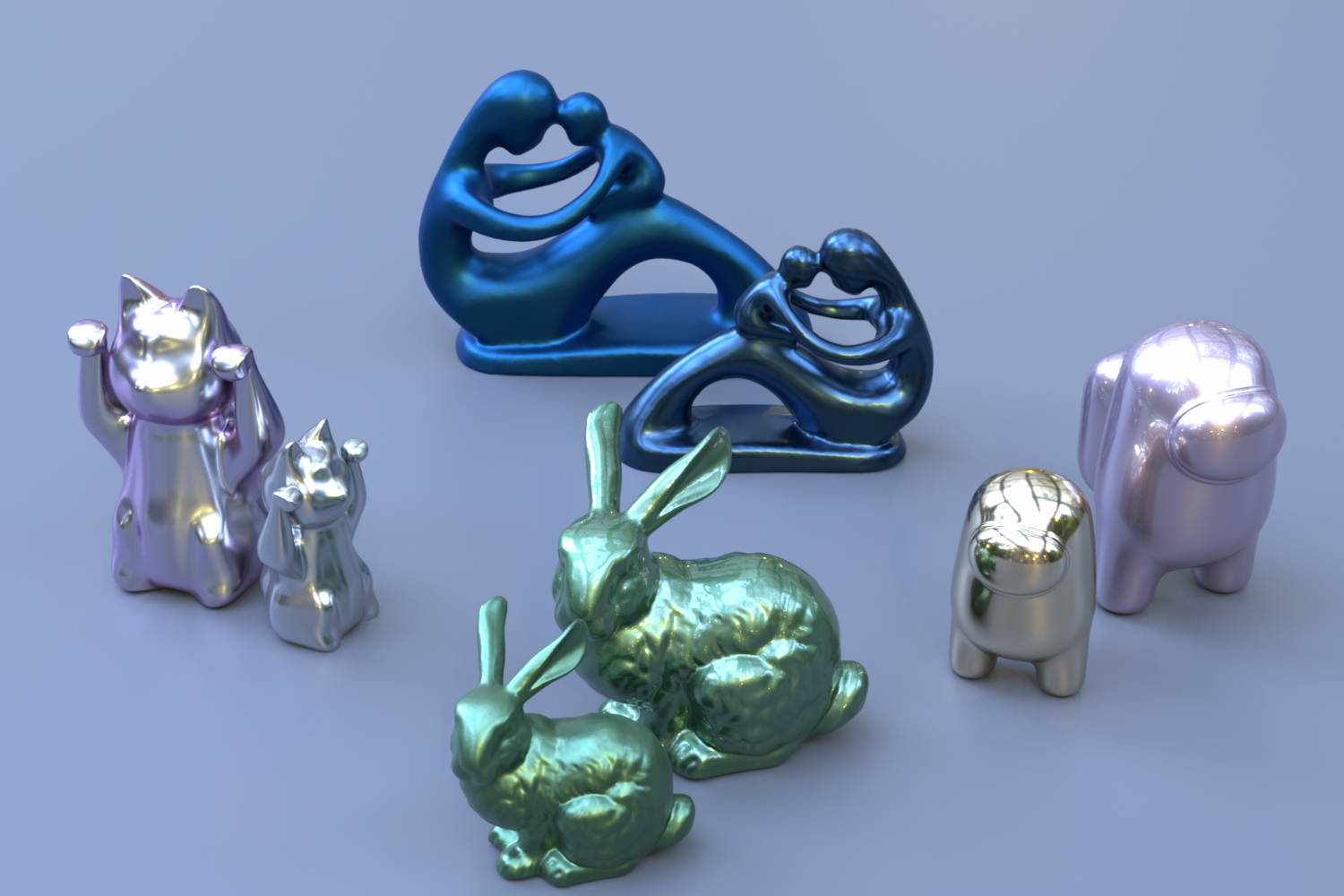
Our method permits to control layered material appearance by automatically retrieving physical parameters. Top: Modification of the color and sharpness of reflections produced by a 2-layer material. Left: Isolated control over grazing-angle colors obtained via a 2-layer material with a conductor base. Bottom: Coating an existing 2-layer material without modifying its underlying appearance. Right: Control over haze extent and color on a 2-layer material with a conductor base
Our method permits to control layered material appearance by automatically retrieving physical parameters. Top: Modification of the color and sharpness of reflections produced by a 2-layer material. Left: Isolated control over grazing-angle colors obtained via a 2-layer material with a conductor base. Bottom: Coating an existing 2-layer material without modifying its underlying appearance. Right: Control over haze extent and color on a 2-layer material with a conductor base
8.3.3 Efficient Spectral Rendering on the GPU for Predictive Rendering
Participants: David Murray, Alban Fichet, Romain Pacanowski.
Current graphic processing units (GPU) in conjunction with specialized APIs open the possibility of interactive path tracing. Spectral rendering is necessary for accurate and predictive light transport simulation, especially to render specific phenomena such as light dispersion. However, it requires larger assets than traditional RGB rendering pipelines. Thanks to the increase of available onboard memory on newer graphic cards, it becomes possible to load larger assets onto the GPU, making spectral rendering feasible. In this chapter 11, we describe the strengths of spectral rendering and present our approach for implementing a spectral path tracer on the GPU. We also propose solutions to limit the impact on memory when handling finely sampled spectra or large scenes.8.3.4 An OpenEXR Layout for Spectral Images
Participants: Alban Fichet, Romain Pacanowski.
In this article 8, we propose a standardised layout to organise spectral data stored in OpenEXR images. We motivate why we chose the OpenEXR format as basis for our work, and we explain our choices with regard to data selection and organisation: our goal is to define a standard for the exchange of measured or simulated spectral and bi-spectral data. We also provide sample code to store spectral images in OpenEXR format.
8.3.5 Visually-Uniform Reparametrization of Material Appearance through Density Redistribution
Participants: Pascal Barla [Unity technologies], Laurent Belcour [Unity technologies], Romain Pacanowski.
Variations of material parameters such as roughness, sheen, etc. do not usually produce visually-uniform changes in rendered images. This might make it detrimental to artistic edition or prefiltering. In this work 12, we provide a methodology to reparametrize non visually-uniform parameters, by uniformly distributing the visual changes across the range of parameter values. For 1D and 2D parameters, our solution boils down to inverting a Cumulative Distribution Function. We provide three concrete applications of this method to reparametrize the complex refractive index, roughness (see Figure 11) and sheen.

Varying material parameters does not usually produce visually-uniform variations of material appearance. For example, in the case of microfacet roughness (top row), the distinctness of the reflected image changes abruptly. We propose a methodology to correct such non-uniform parametrizations (bottom row) by redistributing differences in material appearance to yield visually-uniform variations.
Varying material parameters does not usually produce visually-uniform variations of material appearance. For example, in the case of microfacet roughness (top row), the distinctness of the reflected image changes abruptly. We propose a methodology to correct such non-uniform parametrizations (bottom row) by redistributing differences in material appearance to yield visually-uniform variations.
9 Partnerships and cooperations
9.1 National initiatives
9.1.1 ANR
“Young Researcher” MoStyle (2021-2025)
- INRIA - LaBRI
Leader: P. Bénard
Participant: P. Barla
The main goal of this project is to investigate how computer tools can help capturing and reproducing the typicality of traditional 2D animations. Ultimately, this would allow to produce 2D animations with a unified appearance starting from roughs drawings or 3D inputs.
“Young Researcher” VIDA (2017-2021)
- LP2N-CNRS-IOGS INRIA
Leader: R. Pacanowski (LP2N-CNRS-IOGS)
Participant: P. Barla
This project aims at establishing a framework for direct and inverse design of material appearance for objects of complex shape. Since the manufacturing processes are always evolving, our goal is to establish a framework that is not tied to a fabrication stage.
FOLD-Dyn (2017-2021)
- IRIT, IMAGINE, MANAO, TeamTo, Mercenaries
Leader: L. Barthe (IRIT)
Local Leader: G. Guennebaud
The FOLD-Dyn project proposes the study of new theoretical approaches for the effective generation of virtual characters deformations, when they are animated. These deformations are two-folds: character skin deformations (skinning) and garment simulations. We propose to explore the possibilities offered by a novel theoretical way of addressing character deformations: the implicit skinning. This method jointly uses meshes and volumetric scalar functions. By improving the theoretical properties of scalar functions, the study of their joint use with meshes, and the introduction of a new approach and its formalism - called multi-layer 3D scalar functions - we aim at finding effective solutions allowing production studios to easily integrate in their pipeline plausible character deformations together with garment simulations.
CaLiTrOp (2017-2021)
- IRIT, LIRIS, MANAO, MAVERICK
Leader: M. Paulin (IRIT)
Participant: D. Murray
What is the inherent dimensionality, topology and geometry of light-paths space? How can we leverage this information to improve lighting simulation algorithms? These are the questions that this project wants to answer from a comprehensive functional analysis of light transport operators, with respect to the 3D scene's geometry and the reflectance properties of the objects, but also, to link operators with screen-space visual effects, with respect to the resulting picture.
10 Dissemination
10.1 Promoting scientific activities
10.1.1 Scientific events: selection
Member of the conference program committees
- ACM Siggraph, ACM Siggraph Asia.
- Eurographics
- Symposium on Geometry Processing
- Eurographics Symposium on Rendering
- ACM SIGGRAPH Symposium on Interactive 3D Graphics and Games (i3D)
Reviewer
- ACM Siggraph, ACM Siggraph Asia.
- Eurographics
- Eurographics Symposium on Rendering
- ACM SIGGRAPH Symposium on Interactive 3D Graphics and Games (i3D)
10.1.2 Journal
Reviewer - reviewing activities
- ACM Transactions on Graphics
- Computer Graphics Forum
- Journal of Vision
10.1.3 Invited talks
- The Skin of Things 2021 : "Inverse material depiction"
10.2 Teaching - Supervision - Juries
10.2.1 Teaching
The members of our team are involved in teaching computer science at University of Bordeaux and Institut d'Optique Graduate School (IOGS). General computer science is concerned, as well as the following graphics related topics:
- Master: Pierre Bénard, Gaël Guennebaud, Romain Pacanowski, Advanced Image Synthesis, 50 HETD, M2, Univ. Bordeaux, France.
- Master: Gaël Guennebaud, Geometric Modeling, 31 HETD, M2, IOGS, France.
- Master: Gaël Guennebaud and Pierre Bénard, 3D Worlds, 60 HETD, M1, Univ. Bordeaux and IOGS, France.
- Master: Pierre Bénard, Patrick Reuter, Virtual Reality, 20 HETD, M2, Univ. Bordeaux, France.
- Master: Patrick Reuter, Graphical user interfaces and Spatial augmented reality seminars, 10 HETD, M2, ESTIA, France.
- Master: Romain Pacanowski, 3D Programming, M2, 18 HETD, Bordeaux INP ENSEIRB Matmeca, France.
- Master: Romain Pacanowski, Apperance Modeling, M2, 12 HETD, Bordeaux IOGS, France.
- Licence: Patrick Reuter, Digital Imaging, 30 HETD, L3, Univ. Bordeaux, France.
- Licence: Gaël Guennebaud, Introduction to climate change issues and the environnemental impacts of ICT, 24 HETD, L3, Univ. Bordeaux, France.
One member is also in charge of a field of study:
- Master: Pierre Bénard, M2 “Informatique pour l'Image et le Son”, Univ. Bordeaux, France.
Pierre Bénard was also part of the education team of the DIU (Diplôme Inter-Universitaire) titled “Numérique et Sciences Informatiques” which is opened to secondary professors that are teaching Computer Science in high school. The second session took place during the last three weeks of June.
10.2.2 Supervision
- PhD: Camille Brunel, Time-independent geometrical deformation for elastic contacts, Inria & Univ. Bordeaux, P. Barla, G. Guennebaud & P. Bénard, 12/10/2021.
- PhD: Megane Bati, Inverse Design for Complex Material Apperance, IOGS & Univ. Bordeaux, R. Pacanowski & P. Barla, 16/12/2021.
- PhD in progress: Charlie Schlick, Augmented reality with transparent multi-view screens, Inria & Univ. Bordeaux, P. Reuter.
- PhD in progress: Corentin Cou, Characterization of visual appearance for 3D restitution and exploration of monumental heritage, Inria & IOGS & CNRS/INHA, G. Guennebaud, X. Granier, M. Volait, R. Pacanowski.
- PhD in progress: Melvin Even, Computer-Aided Rough 2D Animation, Inria, P. Barla & P. Bénard.
- PhD in progress: Simon Lucas - Modélisation de l'apparence et rendu des plantes, P. BarlaR. Pacanowski.
- PhD in progress: Gary Fourneau - Modélisation de l’Apparence Visuelle pour l’Écologie Comportementale, P. Barla, R. Pacanowski.
10.2.3 Juries
- PhD Jury: Francois Desrichard, Analysis of the Path Space for Light and Shadow Compositing, IRIT, Université de Toulouse.
11 Scientific production
11.1 Major publications
- 1 articleA Practical Extension to Microfacet Theory for the Modeling of Varying Iridescence.ACM Transactions on Graphics364July 2017, 65
- 2 articleAutostereoscopic transparent display using a wedge light guide and a holographic optical element: implementation and results.Applied optics5834November 2019
- 3 articleA Two-Scale Microfacet Reflectance Model Combining Reflection and Diffraction.ACM Transactions on Graphics364Article 66July 2017, 12
- 4 articleA View-Dependent Metric for Patch-Based LOD Generation & Selection.Proceedings of the ACM on Computer Graphics and Interactive Techniques11May 2018
- 5 articleInstant Transport Maps on 2D Grids.ACM Transactions on Graphics376November 2018, 13
11.2 Publications of the year
International journals
International peer-reviewed conferences
Scientific book chapters
Reports & preprints
11.3 Cited publications
- 13 articleReliefs as images.ACM Trans. Graph.2942010, URL: http://doi.acm.org/10.1145/1778765.1778797
- 14 articleSurface Relief Analysis for Illustrative Shading.Computer Graphics Forum314June 2012, 1481-1490URL: http://hal.inria.fr/hal-00709492
- 15 techreportDistribution-based BRDFs.unpublishedUniv. of Utah2007
- 16 articleTime-resolved 3D Capture of Non-stationary Gas Flows.ACM Trans. Graph.2752008
- 17 bookSpatial Augmented Reality: Merging Real and Virtual Worlds.A K Peters/CRC Press2005
- 18 articleOptimizing Environment Maps for Material Depiction.Comput. Graph. Forum (Proceedings of the Eurographics Symposium on Rendering)3042011, URL: http://www-sop.inria.fr/reves/Basilic/2011/BCRA11
- 19 articleLeast Squares Subdivision Surfaces.Comput. Graph. Forum2972010, 2021-2028URL: http://hal.inria.fr/inria-00524555/en
- 20 articleStyle Transfer Functions for Illustrative Volume Rendering.Comput. Graph. Forum2632007, 715-724URL: http://www.cg.tuwien.ac.at/research/publications/2007/bruckner-2007-STF/
- 21 inproceedingsUnstructured lumigraph rendering.Proc. ACM SIGGRAPH2001, 425-432URL: http://doi.acm.org/10.1145/383259.383309
- 22 articleApplication of radial basis functions to shape description in a dual-element off-axis eyewear display: Field-of-view limit.J. Society for Information Display16112008, 1089-1098
- 23 articleA Survey on Participating Media Rendering Techniques.The Visual Computer2005
- 24 inproceedingsOn-Line Visualization of Underground Structures using Context Features.Symposium on Virtual Reality Software and Technology (VRST)ACM2010, 167-170URL: http://hal.inria.fr/inria-00524818/en
- 25 articleNon-oriented MLS Gradient Fields.Computer Graphics ForumDecember 2013, URL: http://hal.inria.fr/hal-00857265
- 26 articleLight field transfer: global illumination between real and synthetic objects.ACM Trans. Graph.2732008, URL: http://doi.acm.org/10.1145/1360612.1360656
- 27 articleA novel approach makes higher order wavelets really efficient for radiosity.Comput. Graph. Forum1932000, 99-108
- 28 articleA quantized-diffusion model for rendering translucent materials.ACM Trans. Graph.3042011, URL: http://doi.acm.org/10.1145/2010324.1964951
- 29 inproceedingsReflectance and texture of real-world surfaces.IEEE Conference on Computer Vision and Pattern Recognition (ICCV)1997, 151-157
- 30 articleFabricating spatially-varying subsurface scattering.ACM Trans. Graph.2942010, URL: http://doi.acm.org/10.1145/1778765.1778799
- 31 bookAdvanced Global Illumination.A.K. Peters2006
- 32 articleFrequency analysis and sheared filtering for shadow light fields of complex occluders.ACM Trans. Graph.3022011, URL: http://doi.acm.org/10.1145/1944846.1944849
- 33 articleFrequency Analysis and Sheared Reconstruction for Rendering Motion Blur.ACM Trans. Graph.2832009, URL: http://hal.inria.fr/inria-00388461/en
- 34 articleSpecular reflections and the perception of shape.J. Vis.492004, 798-820URL: http://journalofvision.org/4/9/10/
- 35 inproceedingsBRDF Acquisition with Basis Illumination.IEEE International Conference on Computer Vision (ICCV)2007, 1-8
- 36 articleAccurate Light Source Acquisition and Rendering.ACM Trans. Graph.2232003, 621-630URL: http://hal.inria.fr/hal-00308294
- 37 inproceedingsModeling the interaction of light between diffuse surfaces.Proc. ACM SIGGRAPH1984, 213-222
- 38 articlePhysical reproduction of materials with specified subsurface scattering.ACM Trans. Graph.2942010, URL: http://doi.acm.org/10.1145/1778765.1778798
- 39 phdthesisSimulating Global Illumination Using Adaptative Meshing.University of California1991
- 40 articleFluorescent immersion range scanning.ACM Trans. Graph.2732008, URL: http://doi.acm.org/10.1145/1360612.1360686
- 41 articleAcquisition and analysis of bispectral bidirectional reflectance and reradiation distribution functions.ACM Trans. Graph.2942010, URL: http://doi.acm.org/10.1145/1778765.1778834
- 42 articleDynamic Display of BRDFs.Comput. Graph. Forum3022011, 475--483URL: http://dx.doi.org/10.1111/j.1467-8659.2011.01891.x
- 43 articleTransparent and Specular Object Reconstruction.Comput. Graph. Forum2982010, 2400-2426
- 44 inproceedingsA Kaleidoscopic Approach to Surround Geometry and Reflectance Acquisition.IEEE Conf. Computer Vision and Pattern Recognition Workshops (CVPRW)IEEE Computer Society2012, 29-36
- 45 inproceedingsA theory of plenoptic multiplexing.IEEE Conf. Computer Vision and Pattern Recognition (CVPR)\bf oralIEEE Computer Society2010, 483-490
- 46 inproceedingsThe rendering equation.Proc. ACM SIGGRAPH1986, 143-150URL: http://doi.acm.org/10.1145/15922.15902
- 47 inproceedingsFast, arbitrary BRDF shading for low-frequency lighting using spherical harmonics.Proc. Eurographics workshop on Rendering (EGWR)Pisa, Italy2002, 291-296
-
48
articleEdge clustered fitting grids for
-polynomial characterization of freeform optical surfaces.Opt. Express19272011, 26962-26974URL: http://www.opticsexpress.org/abstract.cfm?URI=oe-19-27-26962 - 49 articleDemarcating curves for shape illustration.ACM Trans. Graph. (SIGGRAPH Asia)2752008, URL: http://doi.acm.org/10.1145/1409060.1409110
- 50 articleRecording and controlling the 4D light field in a microscope using microlens arrays.J. Microscopy23522009, 144-162URL: http://dx.doi.org/10.1111/j.1365-2818.2009.03195.x
- 51 articlePredicted Virtual Soft Shadow Maps with High Quality Filtering.Comput. Graph. Forum3022011, 493-502URL: http://hal.inria.fr/inria-00566223/en
- 52 articleProgrammable aperture photography: multiplexed light field acquisition.ACM Trans. Graph.2732008, URL: http://doi.acm.org/10.1145/1360612.1360654
- 53 articleOnline Tracking of Outdoor Lighting Variations for Augmented Reality with Moving Cameras.IEEE Transactions on Visualization and Computer Graphics184March 2012, 573-580URL: http://hal.inria.fr/hal-00664943
- 54 article3D TV: a scalable system for real-time acquisition, transmission, and autostereoscopic display of dynamic scenes.ACM Trans. Graph.2332004, 814-824URL: http://doi.acm.org/10.1145/1015706.1015805
- 55 articleA data-driven reflectance model.ACM Trans. Graph.2232003, 759-769URL: http://doi.acm.org/10.1145/882262.882343
- 56 inproceedingsAcquisition, Synthesis and Rendering of Bidirectional Texture Functions.Eurographics 2004, State of the Art Reports2004, 69-94
- 57 inproceedingsExperimental Analysis of BRDF Models.Proc. Eurographics Symposium on Rendering (EGSR)2005, 117-226
- 58 bookGeometrical Considerations and Nomenclature for Reflectance.National Bureau of Standards1977
- 59 articleOptical computing for fast light transport analysis.ACM Trans. Graph.2962010
- 60 articleVolumetric Vector-based Representation for Indirect Illumination Caching.J. Computer Science and Technology (JCST)2552010, 925-932URL: http://hal.inria.fr/inria-00505132/en
- 61 articleRational BRDF.IEEE Transactions on Visualization and Computer Graphics1811February 2012, 1824-1835URL: http://hal.inria.fr/hal-00678885
- 62 articleCompressive light transport sensing.ACM Trans. Graph.2812009
- 63 articleMulticamera Real-Time 3D Modeling for Telepresence and Remote Collaboration.Int. J. digital multimedia broadcasting2010Article ID 247108, 12 pages2010, URL: http://hal.inria.fr/inria-00436467
- 64 articleOn the relationship between radiance and irradiance: determining the illumination from images of a convex Lambertian object.J. Opt. Soc. Am. A18102001, 2448-2459
- 65 articleA first-order analysis of lighting, shading, and shadows.ACM Trans. Graph.2612007, URL: http://doi.acm.org/10.1145/1189762.1189764
- 66 bookComputational Photography: Mastering New Techniques for Lenses, Lighting, and Sensors.A K Peters/CRC Press2012
- 67 bookHigh Dynamic Range Imaging: Acquisition, Display and Image-Based Lighting.2nd editionMorgan Kaufmann Publishers2010
- 68 articlePocket reflectometry.ACM Trans. Graph.3042011
- 69 articleArcheoTUI-Driving virtual reassemblies with tangible 3D interaction.J. Computing and Cultural Heritage322010, 1-13URL: http://hal.inria.fr/hal-00523688/en
- 70 articleThe zonal method for calculating light intensities in the presence of a participating medium.ACM SIGGRAPH Comput. Graph.2141987, 293-302URL: http://doi.acm.org/10.1145/37402.37436
- 71 inproceedingsA New Change of Variables for Efficient BRDF Representation.Proc. EGWR '981998, 11-22
- 72 inproceedingsSpherical wavelets: efficiently representing functions on the sphere.Proc. ACM SIGGRAPHannual conference on Computer graphics and interactive techniques1995, 161-172URL: http://doi.acm.org/10.1145/218380.218439
- 73 bookRadiosity and Global Illumination.Morgan Kaufmann Publishers1994
- 74 articleFourier Depth of Field.ACM Transactions on Graphics2822009, URL: http://hal.inria.fr/inria-00345902
- 75 articleEfficient Glossy Global Illumination with Interactive Viewing.Computer Graphics Forum1912000, 13-25
- 76 articleBarycentric Parameterizations for Isotropic BRDFs.IEEE Trans. Vis. and Comp. Graph.1122005, 126-138URL: http://dx.doi.org/10.1109/TVCG.2005.26
- 77 bookVisual Perception from a Computer Graphics Perspective.A K Peters/CRC Press2011
- 78 articleAll-Frequency Precomputed Radiance Transfer Using Spherical Radial Basis Functions and Clustered Tensor Approximation.ACM Trans. Graph.2532006, 967-976
- 79 inproceedingsDynamic Stylized Shading Primitives.Proc. Int. Symposium on Non-Photorealistic Animation and Rendering (NPAR)ACM2011, 99-104URL: http://hal.inria.fr/hal-00617157/en
- 80 articleThe influence of shape on the perception of material reflectance.ACM Trans. Graph.2632007, URL: http://doi.acm.org/10.1145/1276377.1276473
- 81 inproceedingsMetropolis light transport.Proc. SIGGRAPH '97annual conference on Computer graphics and interactive techniquesACM/Addison-Wesley Publishing Co.1997, 65-76URL: http://doi.acm.org/10.1145/258734.258775
- 82 articleSurface Flows for Image-based Shading Design.ACM Trans. Graph.3132012, URL: http://hal.inria.fr/hal-00702280
- 83 articleImproving Shape Depiction under Arbitrary Rendering.IEEE Trans. Visualization and Computer Graphics1782011, 1071-1081URL: http://hal.inria.fr/inria-00585144/en
- 84 articleLight warping for enhanced surface depiction.ACM Trans. Graph.283\it front cover2009, 25:1URL: http://doi.acm.org/10.1145/1531326.1531331
- 85 articleImplicit Brushes for Stylized Line-based Rendering.Comput. Graph. Forum302\bf 3\textsuperscriptrd best paper award2011, 513-522URL: http://hal.inria.fr/inria-00569958/en
- 86 articleSoft Textured Shadow Volume.Comput. Graph. Forum2842009, 1111-1120URL: http://hal.inria.fr/inria-00390534/en
- 87 articleKernel Nyström method for light transport.ACM Trans. Graph.2832009
- 88 articlePacket-based Hierarchical Soft Shadow Mapping.Comput. Graph. Forum2842009, 1121-1130URL: http://hal.inria.fr/inria-00390541/en



